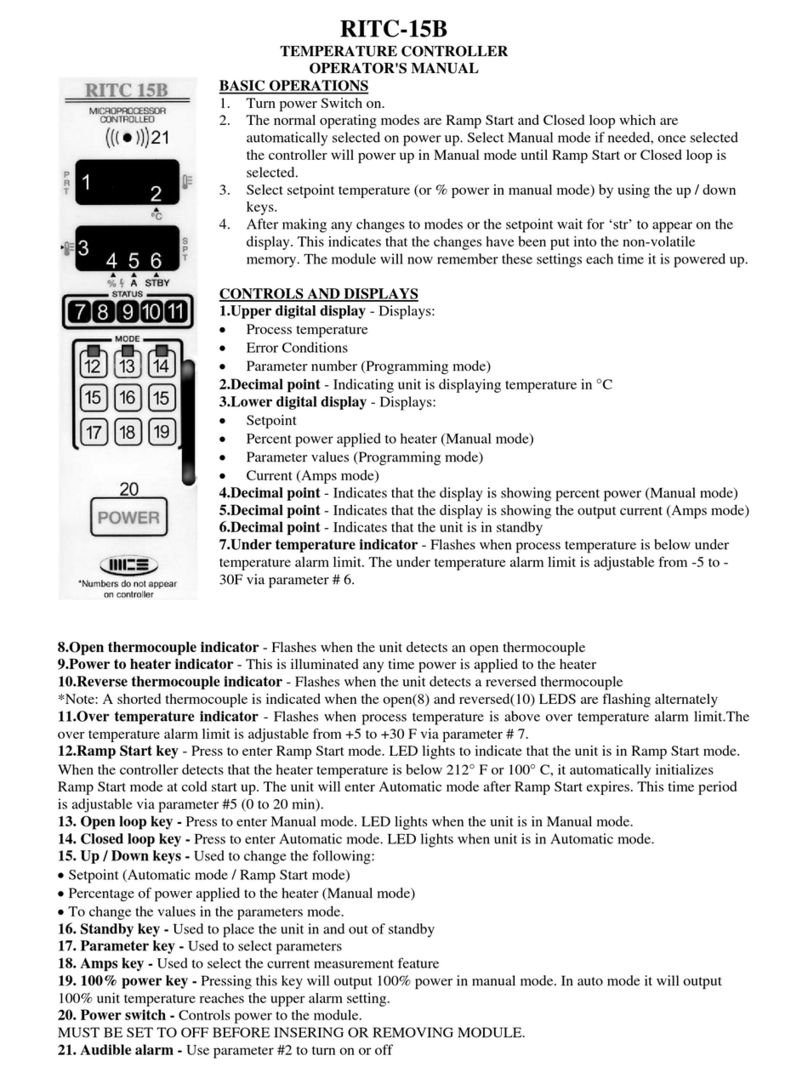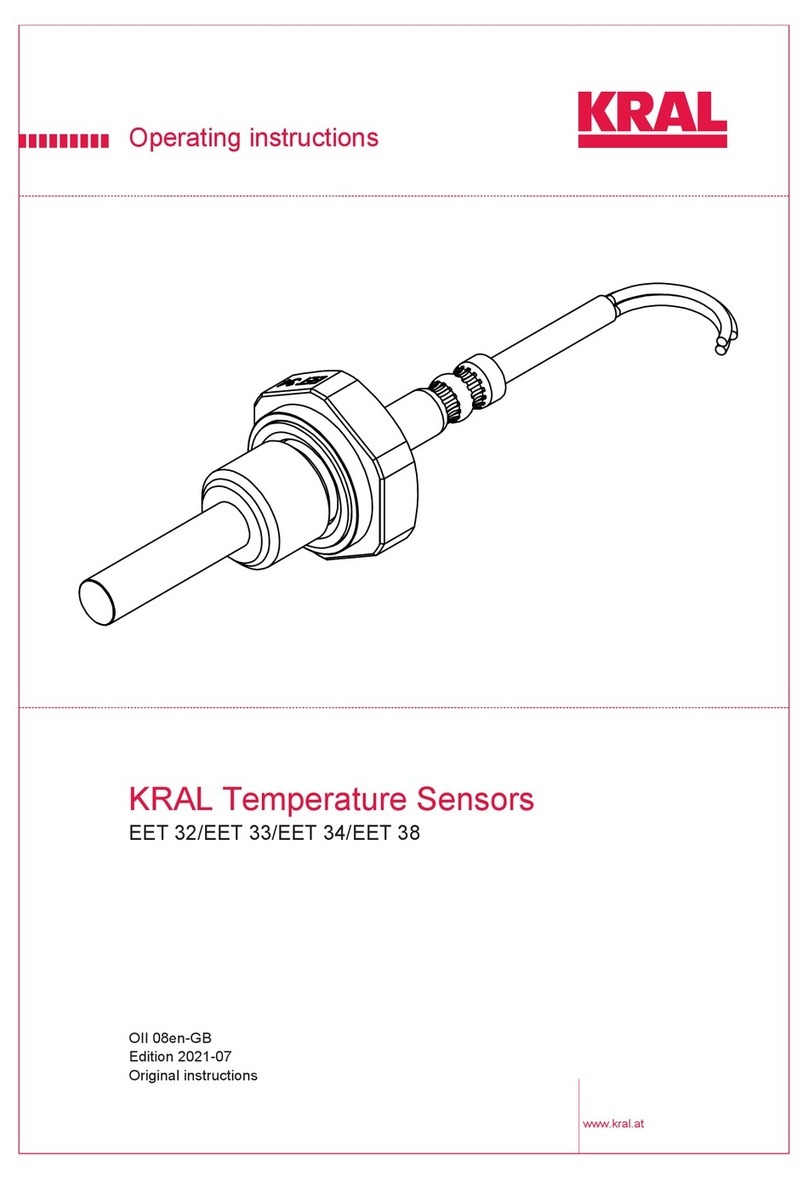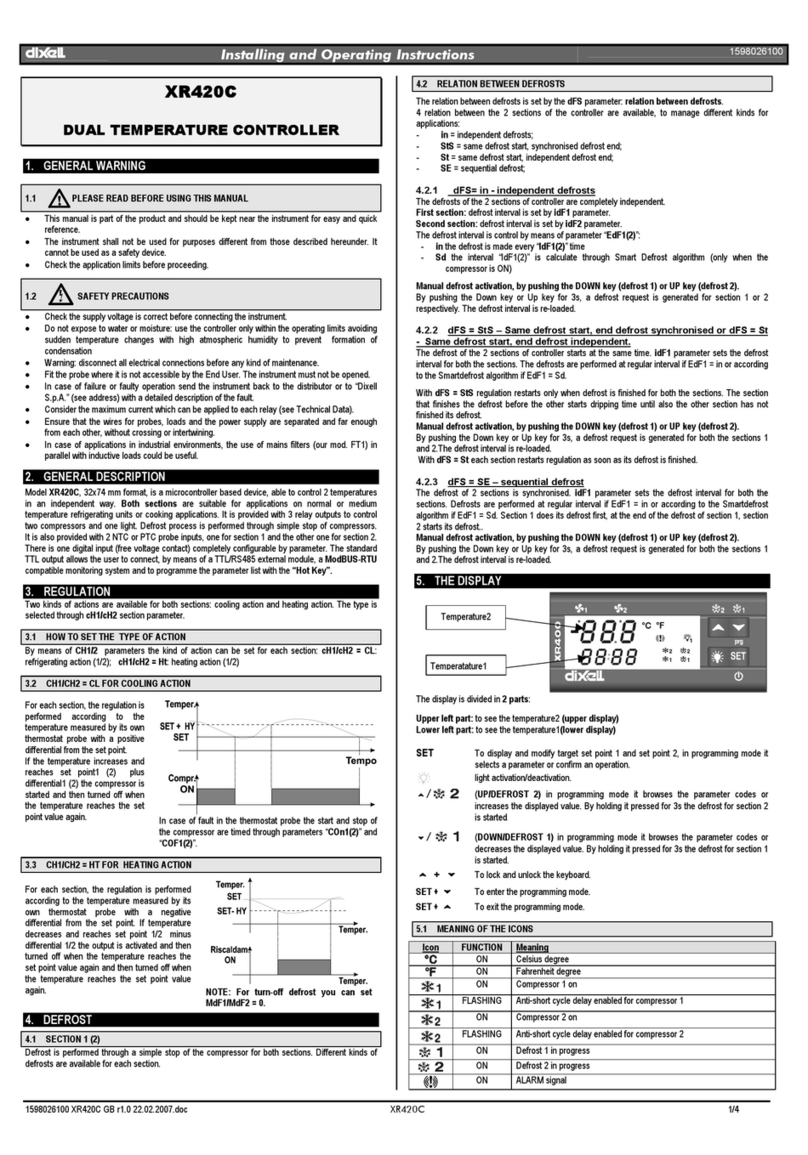RCE10E
INSTALLATION AND
USE GUIDE
Upon completion of the sequence, the controller returns to normal
operation. If a selector s itch is activated during the sequence, the
sequence stops and normal operation is resumed.
2.7.0 TABLE OF PARAMETERS
2.7.1 General description
The controller has a series of configurable parameters, hich make
it suitable for various applications.
The parameters may be configured directly on the thermostat follo ing
the procedure described in 2.8.3.
2.7.2 Table o parameters.
An arbitrary parameter called RESET also appears in the table, hich
may be used to reset all the factory parameters ith one action (factory
settings column)
2.7.3 Setting and changing the parameters.
The control has a button (SW1) in the lo er right part, for accessing
the parameter programming mode and to enter the selection (ENTER).
The central knob of Setpoint (A) is used to select the type of parameter
(from 1 to 10) see table of parameters.
The selector s itch D is used to set the value of the selected parameter
(see table of parameters).
The LED on the right (MODE) visually indicates ith green or red the
value at hich the parameter selected ith D has been set.
The LED on the left (FILTER) blinks fast in the parameter programming
mode.
To enter the parameter programming mode, proceed as follo s:
Turn A fully counter-clock ise (position 5 degrees).
Put C to OFF.
Put D (fan speed selector) to AUTO.
Put E (season change selector) to SUMMER.
Press the button SW1 for at least 5 seconds. The FILTER LED blinks
for the hole time that the user remains in the parameter programming
mode.
3 seconds after entering the parameter mode, the MODE LED comes
on ith a green light if the actual parameter corresponds to the value
selected by D. The LED comes on ith a red light if the actual
parameter is not the same as the set one (see table1).
To enter a ne value, place D on the selected value, (the MODE
LED comes on ith a red light) press the button SW1 and ait for the
MODE LED to come on ith a green light.
Proceed in the same ay for all the parameters to be changed.
To save the ne settings in the permanent storage of the system,
press SW1 for at least 5 seconds. The MODE LED blinks 3 times ith
a green light to confirm that the ne parameters have been saved.
Upon completion of storage, the controller exits from the parameter
setting mode automatically.
2.7.4 Checking the set parameters
Shift A to select the required parameters
Upon moving D, if the MODE LED turns green = the corresponding
value in the table of parameters is currently active
Upon moving D, if the MODE LED turns red = the corresponding
value in the table of parameters is not currently active.
To exit from the parameter checking mode, ait for 2 minutes ithout
touching the button SW1.
The control automatically controls the heat valve to start heating and
the cool valve to start cooling.
Set Parameter 9= T ambient (room temp).
The idth of the neutral zone may be changed ith parameter 1.
The Cooling/Heating s itching is automatic according to the room
temperature and the neutral zone.
The fan is controlled as indicated in paragraph 2.6.1.
Manual s itching.
In this case the Cooling/Heating s itching is manual (using selector
s itch E)
Set Parameter 9 = Manual
The fan is controlled as indicated in paragraph 2.6.1
Centralised s itching.
In this case the Cooling/Heating s itching is accomplished using the
input M16
Set Parameter 9 = H2O/contact.
Set Parameter 10 = Absent.
The fan is controlled as indicated in paragraph 2.6.1
If a heating element is connected to the auxiliary output terminals (M1
M4), the heating element activates in the heating mode to boost
heating hen the selector s itch E is in the heating element position
and Tamb<Setpoint.
2.6.4 2 or 4 pipe an coil control
( ithout regulating valve + possible electrical heating element) Fig.
13.
Set Parameter 2= Fan only
The control is already set for control of just the fan
The cooling/heating s itching may be automatic, manual or centralised.
Manual s itching.
Set Parameter 9 = Manual.
The Cooling/Heating s itching is manual using selector s itch E
Centralised s itching.
Set Parameter 9 = H2O/cont.
Set Parameter 10 = Absent.
In this case the Cooling/Heating s itching is accomplished using the
input M16
Automatic Summer/Winter s itching (for 2 pipe systems only)
Set
Parameter 9=H2O/Contact M16
Parameter 10 = S/W s itching
In this case the Cooling/Heating s itching depends on the temperature
of the outflo ing ater.
If a heating element is connected to the auxiliary output terminals (M1
M4), the heating element activates in the heating mode to boost
heating hen the selector s itch E is in the heating element position
and Tamb<Setpoint.
2.6.5 Starting sequence
To carry out a first test of all the functions upon completion of installation,
proceed as follo s:
Put the Setpoint knob to +5 °C (fully to the right)
Put C to OFF, D to 3, E to Heating Element
Press SW1 for approx. 5 seconds until the MODE LED blinks red
and green alternately and the FILTER LED blinks fast
Fan speed 1 activates for 10 seconds
Fan speed 2 activates for 10 seconds
Fan speed 3 activates for 10 seconds
Fan speed 1 activates again
The heat valve actuator activates for a time T and then stops
The cool valve actuator activates for a time T and then stops
The auxiliary output activates for 5 seconds.
The sequence ends automatically at the end of the cycle. It can also
be stopped by pressing the button SW1 at any time.
N.B. The actuator control time T is:
5 seconds hen parameter 4= ON/OFF and PWM
180 seconds parameter 4= Thermal
7



























